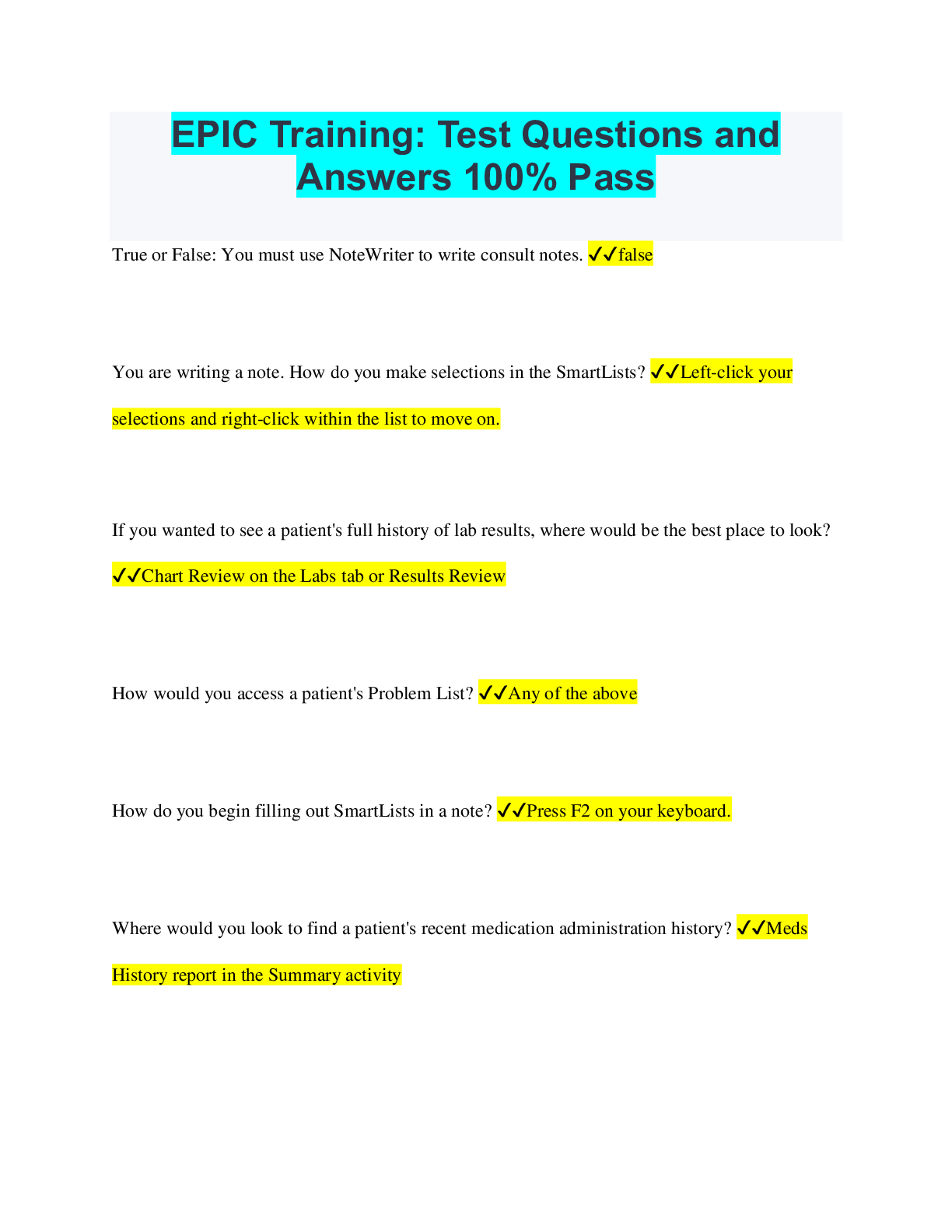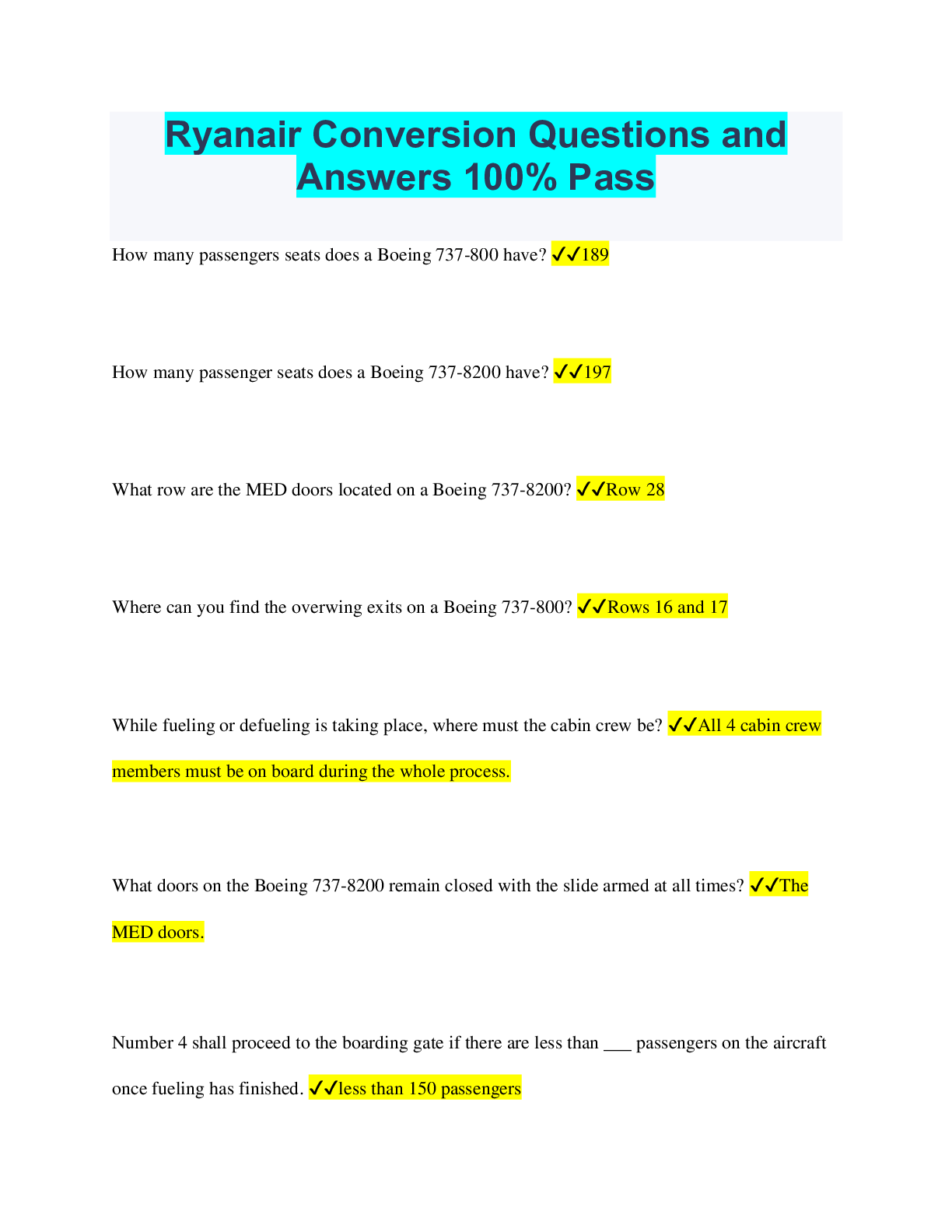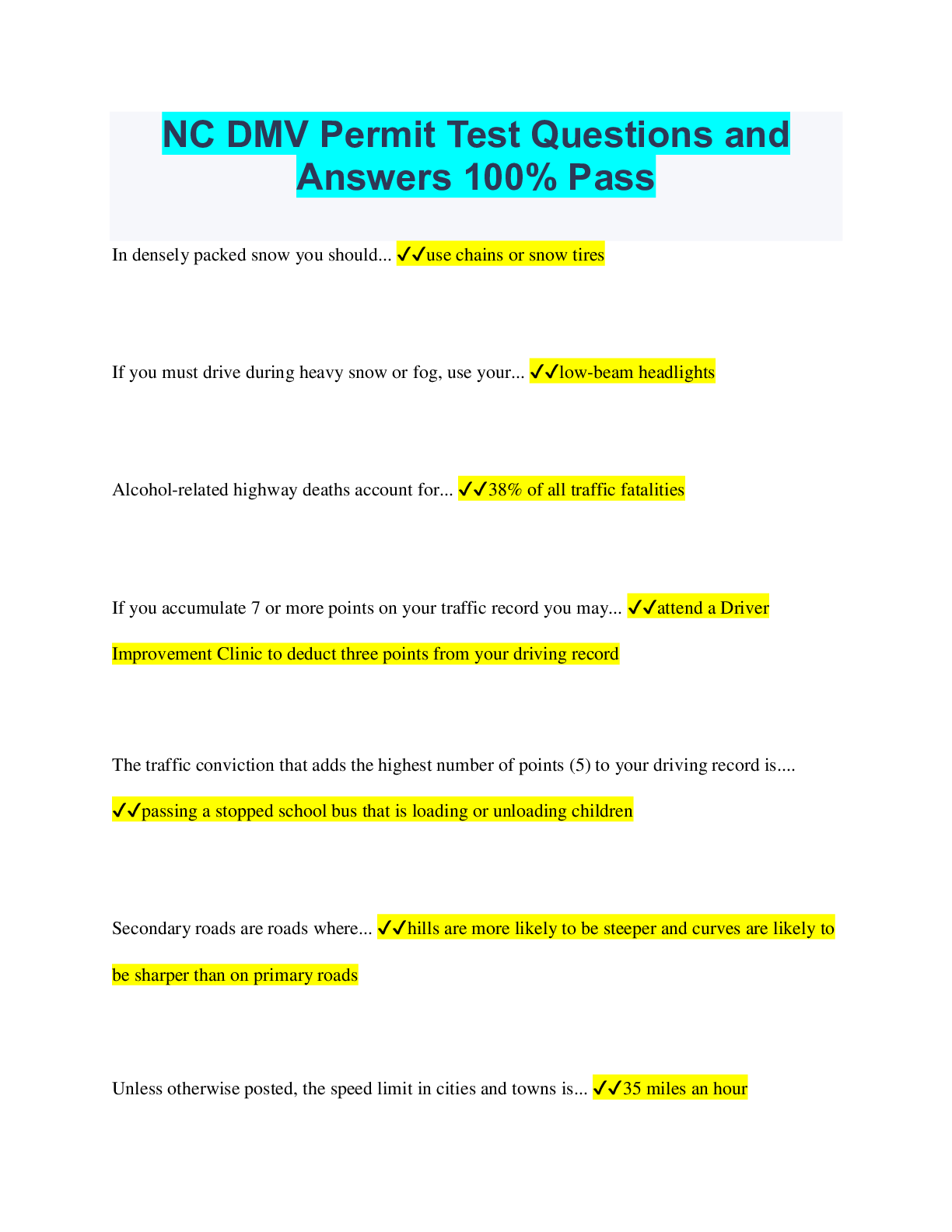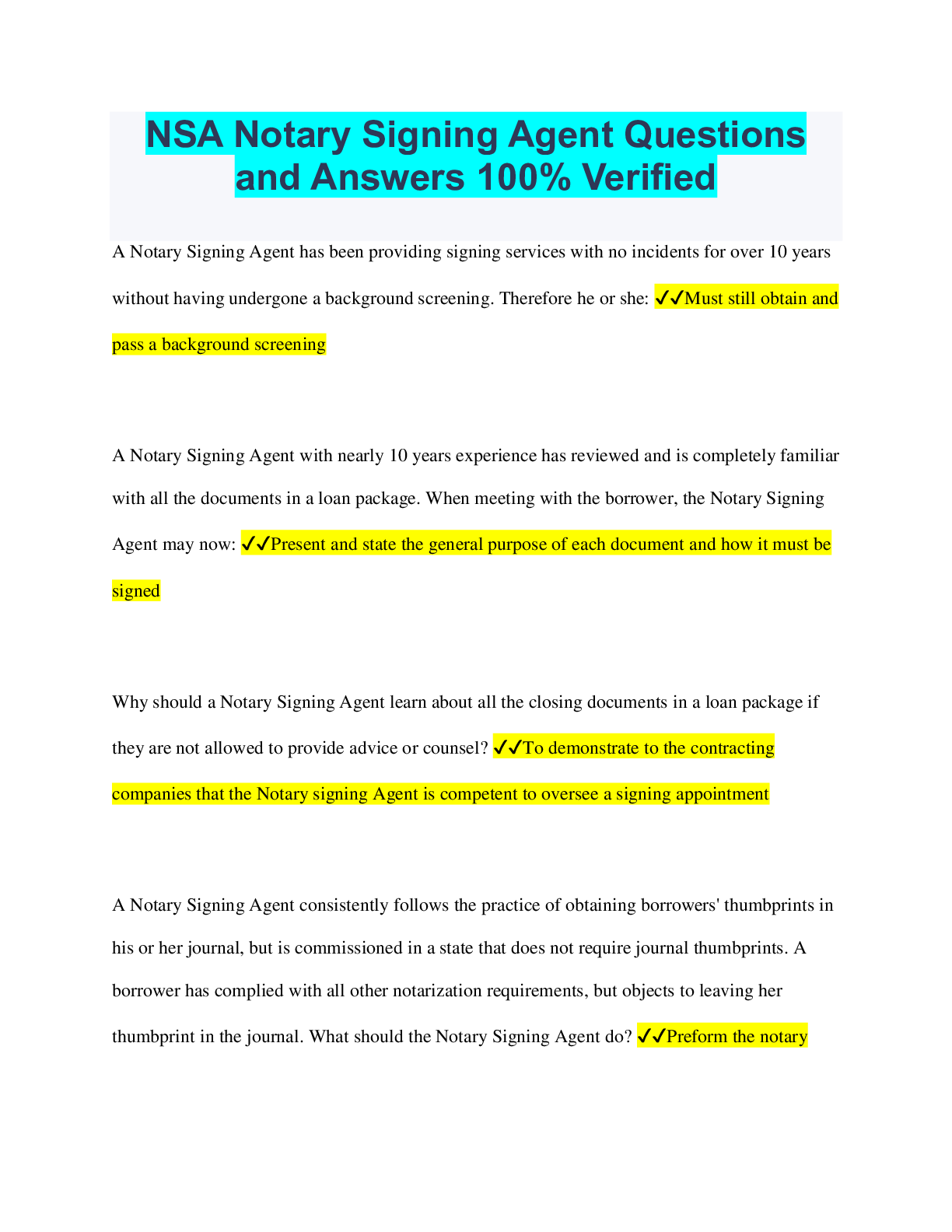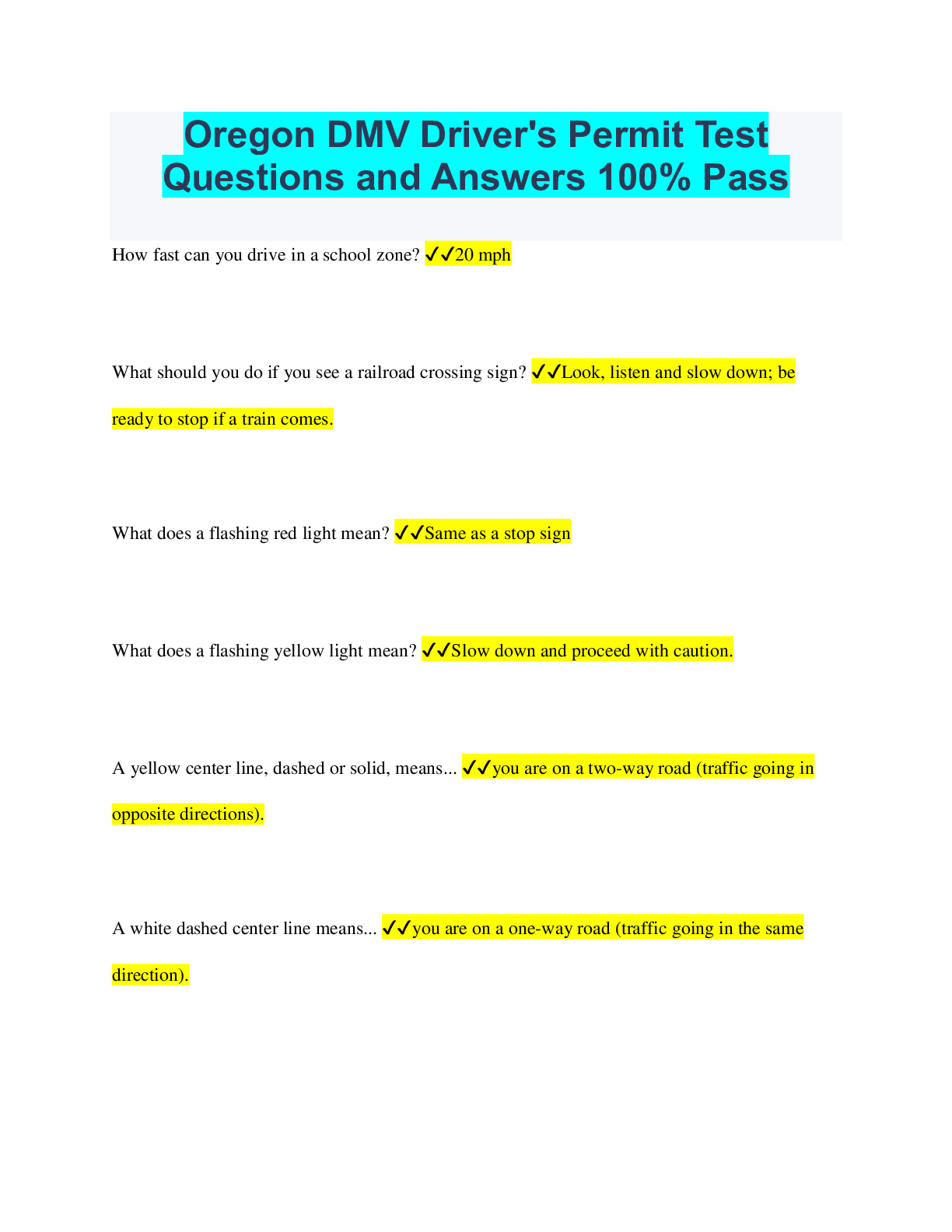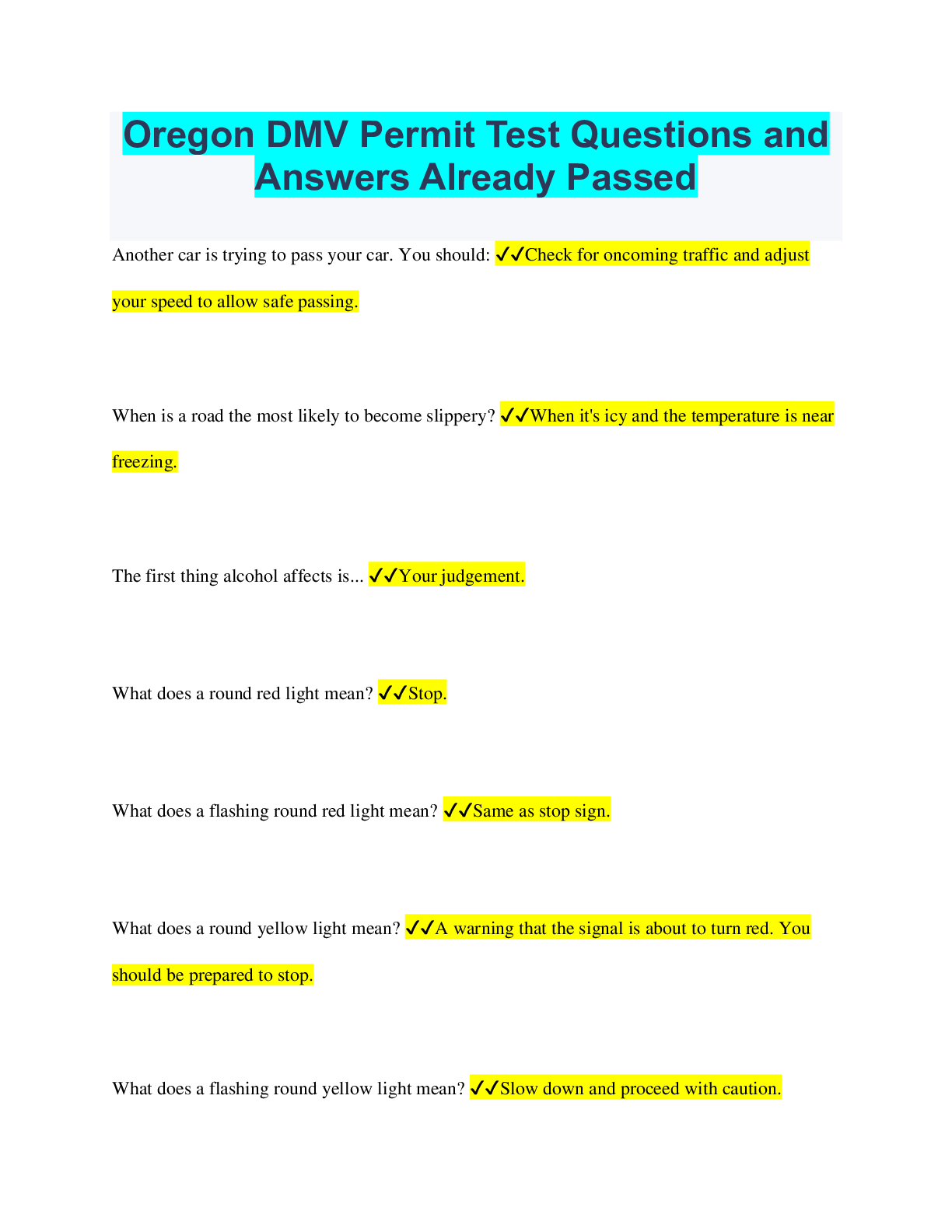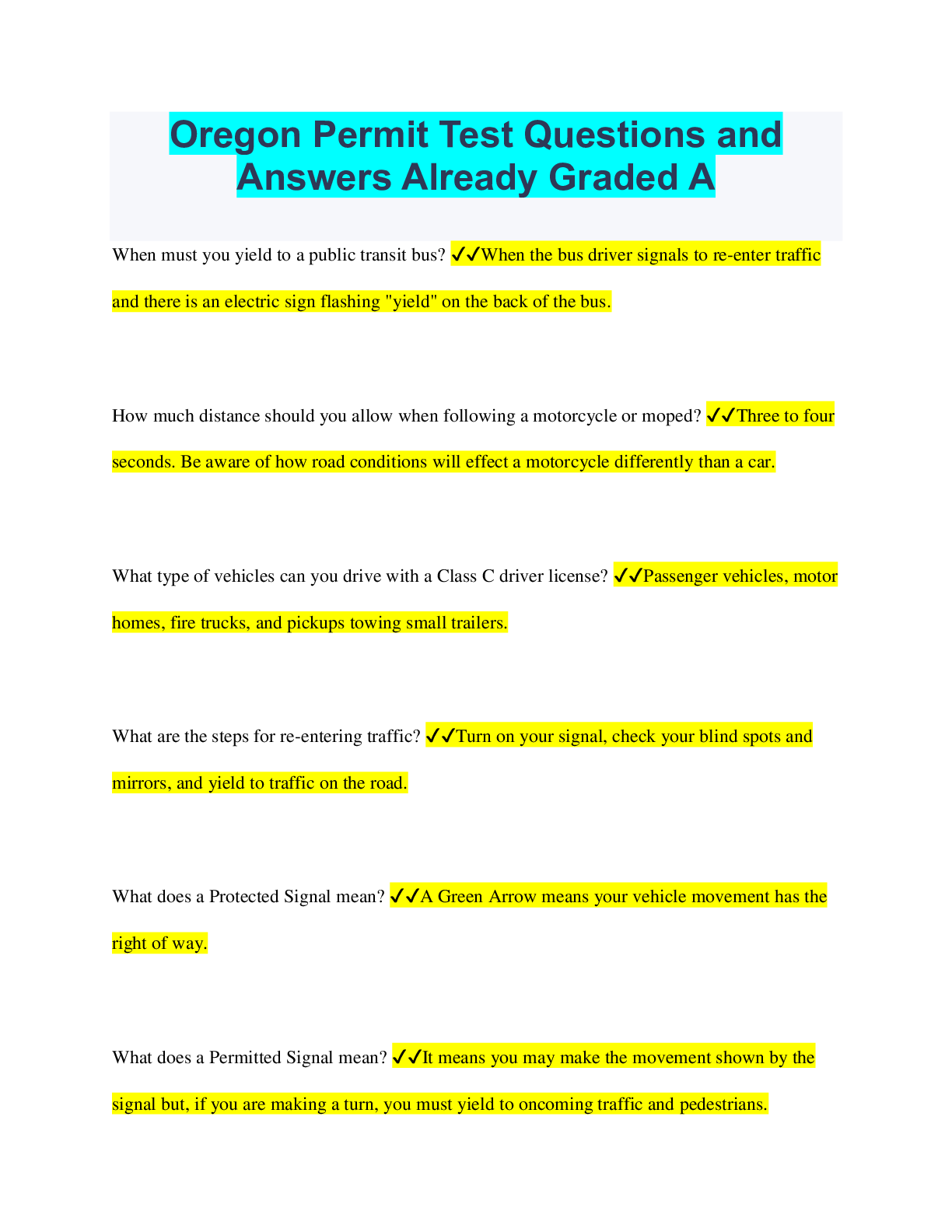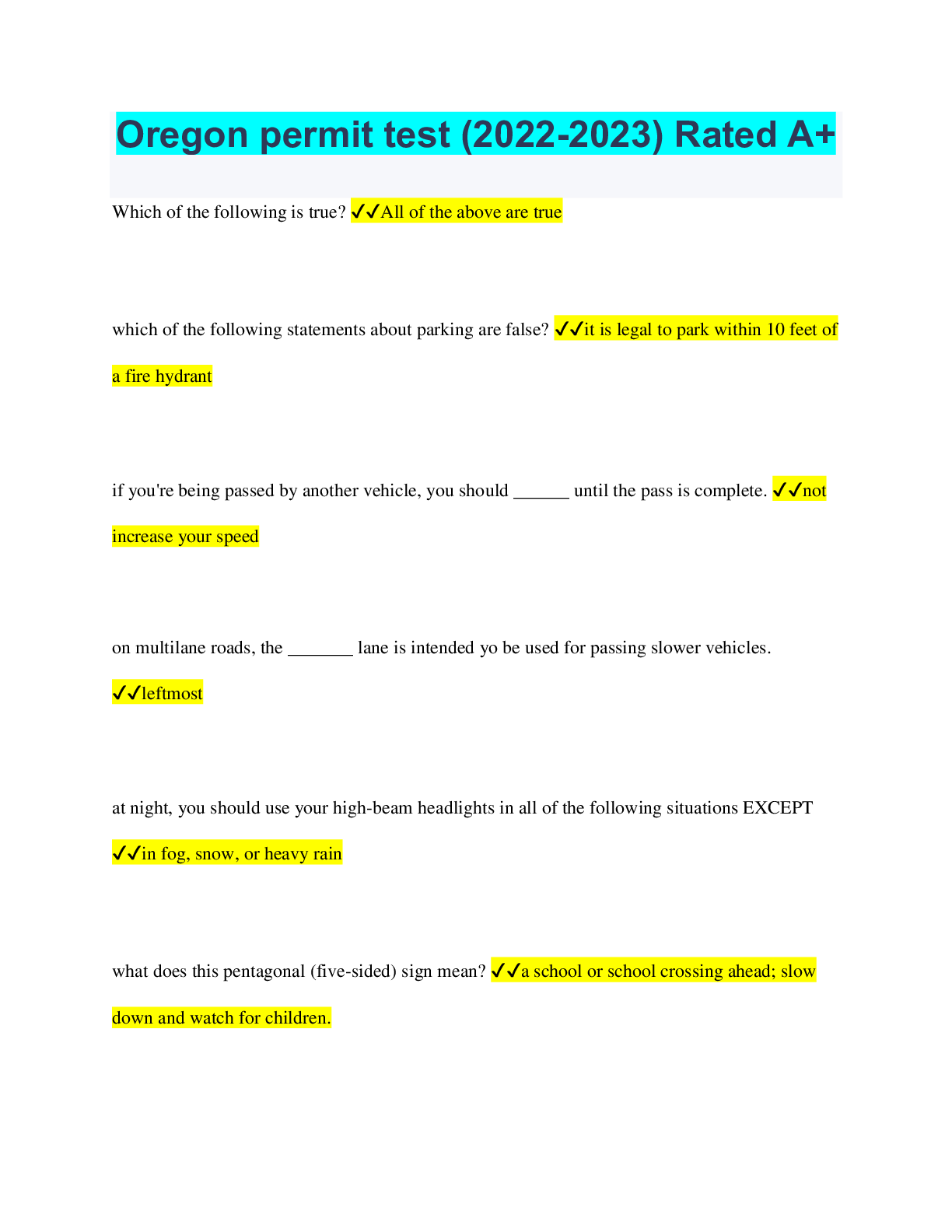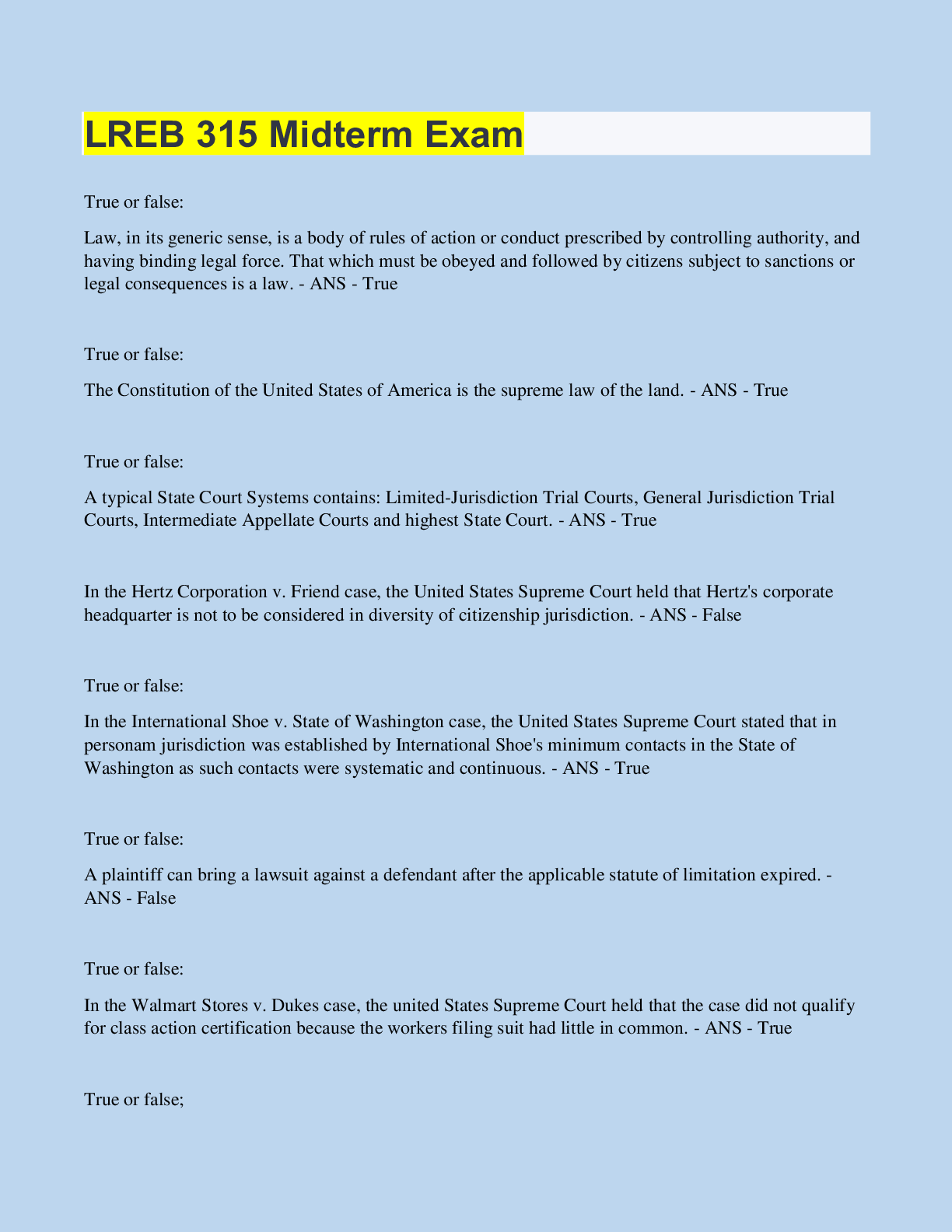*NURSING > QUESTIONS & ANSWERS > RN Practice Exam Pediatric Nursing_2022 | RN Pediatric Nursing Exam (All)
RN Practice Exam Pediatric Nursing_2022 | RN Pediatric Nursing Exam
Document Content and Description Below
HESI Practice Exam - Pediatric Nursing 1. Post-op cleft lip repair → minimize crying to prevent stress on the suture line and promote healing (optimum for cosmetic healing) 2. Restraint used for t... oddler with cleft lip repair → elbow restraints to prevent child from bending arm and bringing up hands to oral surgical site a. Hand restraints – can still bend forward b. Mummy restraints – only used for a short period of time during invasive procedures c. Jacket restraints – restrains body torso (not appropriate) 3. 4-year old with cystic fibrosis (being taught inhalation therapy) will be in what stage of psychosocial development (Erikson) → Initiative (they enjoy being active and participating in role play a. Trust vs Mistrust (birth – 1 year) b. Autonomy vs Shame/Doubt (1 – 3) c. Initiative vs Guilt (3 – 6) d. Industry vs Inferiority (6 – 12) e. Identity vs Role Confusion (12 – 18) 5. Following the reduction of an incarcerated inguinal hernia, a 4-month old is going in for an inguinal hernia repair. What should be reported to the HCP by the parents prior to surgery? → Presence of inguinal bulge after gentle palpation after implanting simple procedures (gentle palpation, warm bath, comfort to reduce crying) because this can indicate that the hernia is irreducible. If a loop of intestines is forced into the inguinal ring or scrotum and incarcerates, swelling can follow and possible strangulation of the bowel, intestinal obstruction, or gangrene of the bowel loop can occur (emergency surgery) a. Hernia – a condition in which intra-abdominal fat or part of the small intestine, also called the small bowel, bulges through a weak area in the lower abdominal muscles b. Incarcerated inguinal hernia – a hernia that becomes stuck in the groin or scrotum and cannot be massaged back into the abdomen 1 6. Sequence of taking vital signs in a child → respiratory rate, heart rate, axillary temperature because touching infants can upset them and make them cry causing an ↑ in heart rate and making respirations difficult to count. Temperature is the most invasive procedure, so it should be saved for last 7. What can cause impaired mobility in a child with rheumatoid arthritis (RA)? → joint inflammation and pain are typical manifestations of exacerbated JRA a. Juvenile rheumatoid arthritis (JRA) is a term used to describe a common type of arthritis in children. It is a long-term (chronic) disease resulting in joint pain and swelling. b. The cause of JRA is not known c. It is thought to be an autoimmune illness. This means the body's immune system mistakenly attacks and destroys healthy body tissue. 8. Risk factors for developmental dysplasia of the hip (DDH) → breech position (head up), females (twice as many females present in breech position), first-born child because the uterus is not as stretched and there is a compaction on the uterus from the surrounding abdominal contents in a nulliparous woman) a. Developmental dysplasia of the hip (DDH) – a dislocation of the hip that presents at birth 9. A 16-year old refuses visitation from students and tells the nurse he is concerned of his edematous facial features. Interventions should be implemented according to what nursing diagnosis? → Social isolation (peer acceptance and body image are significant issues in growth and adolescence. The pt. has a lack of contact with peers stemming from his desires to protect his ego. 10. Nurse is preparing a child with intussusception for a barium enema. What is the main purpose of this procedure? → To reduce the invaginated bowel segment. Other names for intussusception are invagination or telescoping. It causes an intestinal obstruction in children 3 months – 5 years. Nonsurgical treatment includes barium instillation because it ↑ the hydrostatic pressure to ↓ the area of intussusception. This negates the need for surgery. The pressure of the barium (liquid mixture) unfolds the bowel that has been turned inside out and instantly cures the blockage. Air can also be used in the same way to fix the blockage a. Intussusception occurs when one portion of the bowel slides into the next, much like the pieces of a telescope. It can create a blockage in the bowel, with the walls of the intestines pressing against one another. This leads to swelling, inflammation, and decreased blood flow to the part of the intestines involved. b. Signs and symptoms - intense abdominal pain (begins very suddenly and causes loud, anguished crying causing the child to draw the knees up). The pain is usually intermittent, but recurs and may become stronger. Other s/s are abdominal swelling or distention vomiting, vomiting up bile (a bitter-tasting yellowish-green fluid), passing stools (or poop) mixed with blood and mucus (known as currant jelly stool), grunting due to pain 12. The parents of a child with a cyanotic heart defect should be taught what when their child is experiencing a hypercyanotic spell? → assume a knee-chest position Pathophysiology → In a typical case of TOF the pressures in the right ventricle and left ventricle are equal. Hence the level of cyanosis and onset of cyanotic spell is determined the systemic vascular resistance and the 2 slightly elevated to restore hemodynamic equilibrium a. Cyanotic spell is also known as ‘tet’ spell or hypercyanotic spell. This is a sudden onset, occasionally progressive event seen in infants with Tetralogy of Fallots. It is associated with progressive cyanosis, hyperpnea (increased rate and depth of breathing) and disappearance of heart murmur. If not treated in time it may ultimately lead to altered sensorium, neurological complications and death. level of pulmonary stenosis component. In case of mild pulmonary stenosis the right ventricular pressures are usually less than the left ventricle and hence the shunt is usually left to right. However, if the pulmonary stenosis is severe (due to any of the causes described later) then the right ventricular after load becomes high and hence the right ventricular pressures become high. If the systemic vascular resistance is low (which is usually the case in TOF with cyanotic spells) then the shunt flow becomes right to left. This results in progressive cyanosis. Low arterial pO2s (partial pressure of oxygen that is a measure of how well the body is transporting oxygen) lead to stimulation of the carotid receptors and the brain stem nuclei respectively which then leads to increased rate and depth of breathing which further increases the venous return to the right side of the heart and further right to left shunt of deoxygenated blood, thus leading to a vicious cycle. If not broken then it would ultimately lead to death 13. 18-month old returns from getting a cardiac catheterization wit a cannulated femoral artery site. What intervention should the nurse implement? → Show the parent how to hold the child with the extremity extended to prevent trauma to the femoral catheterization. Only the location catheterized requires immobilization a. Cardiac catheterization involves passing a thin flexible tube (catheter) into the right or left side of the heart, usually from the groin or the arm. This is to: i. Collect blood samples from the heart ii. Measure pressure and blood flow in the heart's chambers and in the large arteries around the heart iii. Measure the oxygen in different parts of heart iv. Examine the arteries of the heart v. Perform a biopsy on the heart muscle 14. A child with asthma has a theophylline level of 15 mcg/dl. What should the nurse getting ready to change shifts do? → Communicate the result to the oncoming nurse and document a. Theophylline is a bronchodilator. It works by relaxing muscles in the lungs and chest, and makes the lungs less sensitive to allergens and other causes of bronchospasm. b. Theophylline is used to treat the symptoms of asthma, bronchitis and emphysema. c. A therapeutic level is from 10-20 mcg/dl 3 15. Twins (male and female) are 5 inches apart in height (the girl is taller). What can explain this? → The normal growth spurt in girls (9.5-14 years of age) 1-2 years before boys (10.5-16 years of age) 16. A child is admitted to the hospital for confirmation of a diagnosis of acute lymphoblastic leukemia (ALL). What would be the presenting symptoms? → Bone pain and pallor a. Leukemic cells invade the bone causing weakened bones with a tendency to fracture. As leukemic cells invade the periosteum, ↑ pressures cause severe bone pain and ↓ erythrocytes (RBCs) cause pallor. 17. A nurse is assessing a teen’s knowledge of birth control and says he knows the information already. What should the nurse do? → Ask the teen what he knows to assess his knowledge. Teens tend get information from their peers, which can be incorrect. 18. A burned child is brought to the hospital and the nurse is assessing them according to the “Rule of Nines” to estimate the percentage of body burned. What part of the child’s body is proportionally larger than the adult’s? → Head and neck a. The “Rule of Nines” is inaccurate in estimating burned body surface in children. b. There are specifically designed charts to do this for children 19. Pre-op nursing intervention for a child with pyloric stenosis → observe for projectile vomiting; classic sign that contributes to metabolic alkalosis a. Pyloric stenosis is a medical emergency, not a surgical emergency b. The patient should not be operated on until there has been adeq [Show More]
Last updated: 2 years ago
Preview 1 out of 33 pages

Buy this document to get the full access instantly
Instant Download Access after purchase
Buy NowInstant download
We Accept:

Reviews( 0 )
$14.00
Can't find what you want? Try our AI powered Search
Document information
Connected school, study & course
About the document
Uploaded On
Apr 11, 2022
Number of pages
33
Written in
Additional information
This document has been written for:
Uploaded
Apr 11, 2022
Downloads
0
Views
87

.png)


